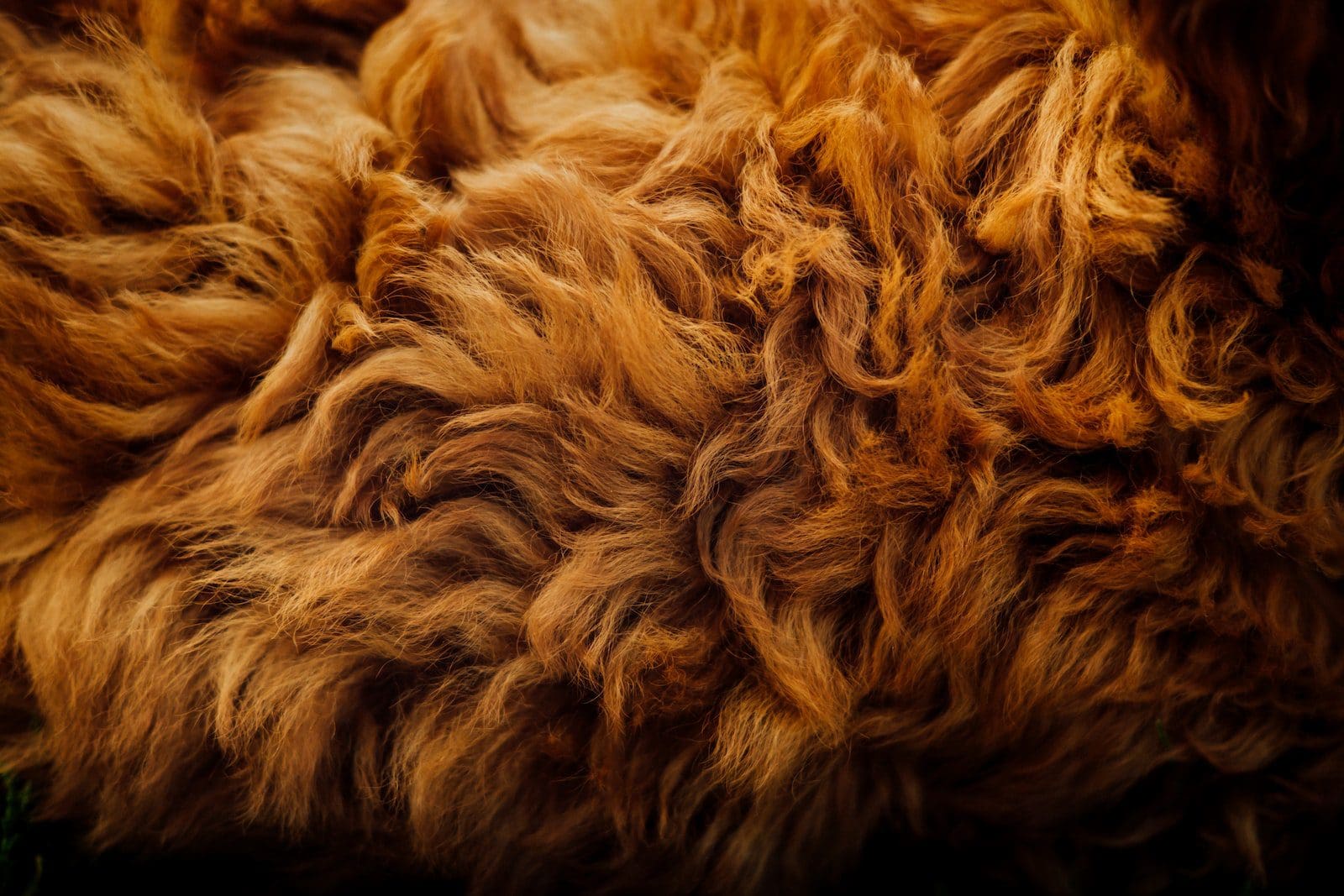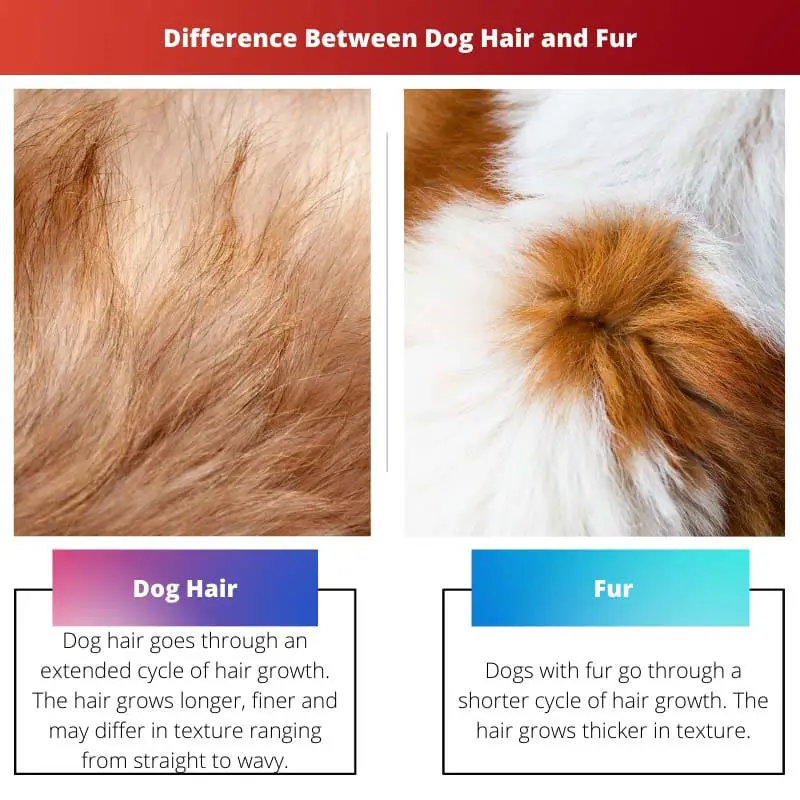Have you ever wondered whether your companion at home has a hair coat or fur? The terms hair and fur may be used interchangeably.
They have scientifically similar compositions made from keratin. But do hair and fur essentially consist of similar texture, length, or appearance?
Key Takeaways
- Dog hair refers to the longer, coarser hairs on a dog’s body that provide insulation.
- Fur refers to the softer, shorter hairs that cover a dog’s body and protect its skin.
- While the terms are used interchangeably, hair and fur differ in texture, length, and purpose.
Dog Hair vs Fur
“Dog Hair” refers to hair on a dog’s body, specifically hair from breeds that grow long hair continuously and require regular trims, like humans. “Fur” refers to hair on a dog’s body, specifically hair from the breeds that have a maximum length they grow to and then shed.

Dog hair is made up of keratin. It goes through a longer growth cycle. Hair grows longer with a longer anagen phase. Due to the continuous growth of hair, it tends to be wavy and less allergic to reactions.
Dogs with hair shed less often. Hair tends to be thinner and finer.
Fur goes through a shorter phase of hair growth. Dogs with fur shed more often, and hence, the fur tends to be thicker and denser.
In winter, fur grows denser to protect from the cold weather and produce warmth. Some of the breeds with fur are Kuvasz, Akbash, American Eskimo, Maltese, etc.
Comparison Table
| Parameters of Comparison | Dog Hair | Fur |
|---|---|---|
| Growth cycle | Dog hair goes through a lengthy growth cycle. | Fur goes through a shorter growth cycle. |
| Texture | It has a fine texture making hair wavy. | It is thicker than hair. |
| Shedding | It sheds less as wavy hair traps shredded hair. | It sheds constantly. |
| Allergic reaction | As the shredded hair gets trapped, it is less likely to produce an allergic reaction. | It is more likely to produce an allergic reaction. |
| Breed | Some of the dog breed with hair includes Yorkshire terriers, Poodles, Shih Tzu, etc. | Some dog breed with fur includes Pomeranian, Bichon Frise, etc. |
What is Dog Hair?
Dog hair goes through an extended cycle of hair growth. The hair grows longer, finer and may differ in texture ranging from straight to wavy. Dogs with hair go through a longer duration of new hair growth or anagen phase.
This duration makes their hair shed slowly and hence trapping any excess hair shedding. The dirt particles and follicles are trapped in the coats. Usually, they have a single coating that does not support adapting to a colder environment.
Some of the breeds include
- Poodles: Poodles vary in their size. A toy poodle is 10 inches in height, miniatures are utmost 15 inches, and standards are at most 15 inches tall. They have short hair and minimal shedding.
- Shih Tzu: Shih Tzu has silky, long, and elegant hair. They do not shed hair all over the house. Their hairs are trapped by an undercoat which produces short hairs.
- Yorkshire Terriers: They are toy-sized, having silky hairs. Their coats are thick and need regular grooming. They are less likely to cause allergic reactions.
Some of the most famous breeds of dog known for their long silky hairs are Afghan Hound, American Eskimo, Bearded Collie, Skye Terrier, English Setter, Coton de Tulear, Shetland Sheepdog, Tibetan Terrier, Briard, Havanese, among others.
These breeds of dogs are found in different places and vary significantly in size. The most common trait is their long, silky, and elegant hairs marking their beautiful appearance.

What is Fur?
Dogs with fur go through a shorter cycle of hair growth. The hair grows thicker in texture. Dogs with fur go through a shorter duration of new hair growth or anagen phase.
This shorter duration makes their fur shed quickly and thus shedding undercoats during spring. Usually, they have a double coating to adapt their body to a colder environment.
Undercoat gives them warmth in winter and makes them appear soft and fluffy. The fur dogs adapt well to cold climates.
Some of the breeds include
- Samoyed: Samoyed found their origin in Siberia. They are cute and fluffy. Their double coat fur is shredded continuously, needing extra care.
- Old English sheepdog: Old English sheepdogs have long and fluffy coats. They weigh around 90 pounds and shed heavily. Their whole body is covered in fur. Their eyes and face are fully covered, making it difficult for them to see objects. They need to be groomed frequently.
Some of the most famous breeds of dog known for their smooth and fluffy fur are German shepherd, Newfoundland, Great Pyrenees, Tibetan mastiff, and Siberian husky, among others.
They adapt to cold climates. They need regular brushing and grooming as their fur is heavily shredded.

Main Differences Between Dog Hair and Fur
- Dog hair passes through the extended anagen phase, while fur goes through a shorter anagen phase.
- Dog hair is lengthier, turning into a curly or wavy texture. On the other hand, fur grows quickly and hence sheds rapidly.
- Dog hair has a single coat, i.e., without an undercoat, whereas fur is protected with a double coat.
- Dog hair is nonallergic, whereas fur is more drawn to allergic reactions.
- Dog hair is not able to control outer temperatures, while fur has denser coats that provide warmth and control outer temperatures.

- https://onlinelibrary.wiley.com/doi/abs/10.1111/j.1365-2222.1985.tb02260.x
- https://www.sciencedirect.com/science/article/pii/S0304401707006620

The detailed descriptions of various dog breeds with hair and fur are very insightful. It’s interesting to learn about different dogs and their coat types.
Yes, it’s fascinating to understand how the coat types of different dog breeds vary and why it is essential to their care.
I found the comparison table very helpful, it clearly outlines the differences between dog hair and fur. I’ll keep this in mind when choosing a dog to adopt.
Absolutely. Knowing the characteristics of dog hair and fur is beneficial when selecting a pet.
I agree, great emphasis on the distinction between hair and fur.
The article is extremely informative and well-structured. It’s crucial to be aware of the differences between dog hair and fur to take care of pets appropriately.
I couldn’t agree more. This information provides great insights into maintaining dogs with different coat types.
Great article explaining the difference between dog hair and fur. It is important to understand the traits of each to better care for the dog.
I agree. It’s essential to be informed about this because it can impact the kind of grooming and maintenance that dogs need.
I found the comparisons between dog hair and fur very enlightening. It’s essential to have this knowledge when considering dog adoption.
Absolutely, having a clear understanding of dog hair and fur can facilitate informed decisions when choosing a pet.
I appreciate the specific breed examples in the article; it helps clarify the distinction even further.
Absolutely, the examples demonstrate the unique characteristics of dog hair and fur in various breeds.
Yes, the breed examples are very useful to understand how hair and fur differ across different dog breeds.
I appreciate the detailed comparison of the growth cycle, texture, and shedding characteristics of dog hair and fur. Very informative!
This article greatly contributes to understanding the unique qualities of dog hair and fur, which is crucial for responsible pet ownership.
Agreed. The detailed analysis of the traits of dog hair and fur is enlightening and valuable for dog owners.
The article provides an excellent comparison of various dog breeds with hair and fur. It’s extremely beneficial for anyone considering getting a dog.
I couldn’t agree more. This detailed comparison certainly aids in making informed decisions about choosing the right dog based on coat type.
The distinction between dog hair and fur is well-explained in the article. It highlights the importance of knowing how to cater to different dog coat types.
Absolutely, this article provides a comprehensive understanding of the differences and care requirements for hair and fur dogs.
The detailed descriptions of the characteristics of fur dogs are fascinating. This article provides valuable insights into dog coat types.
Indeed, understanding the differences between fur and hair in dogs is essential to caring for them effectively.